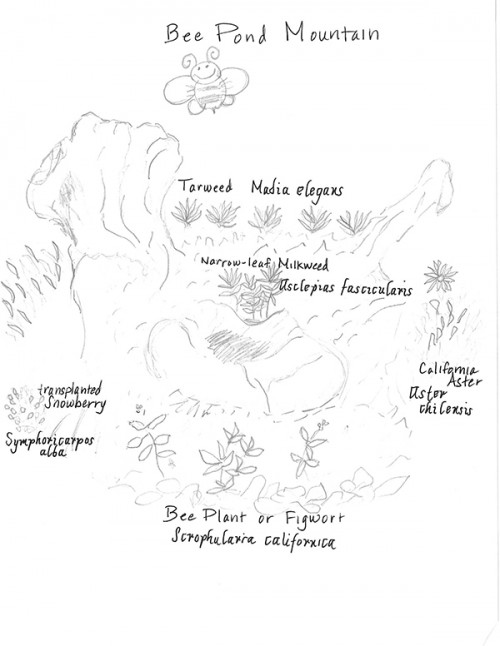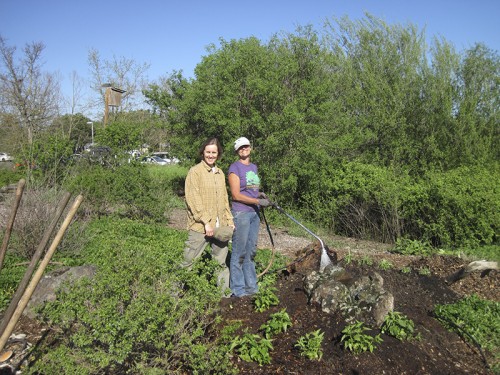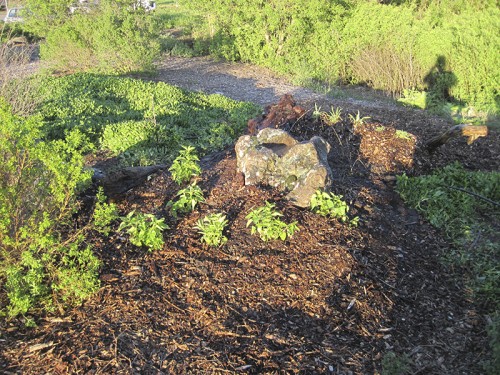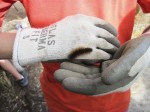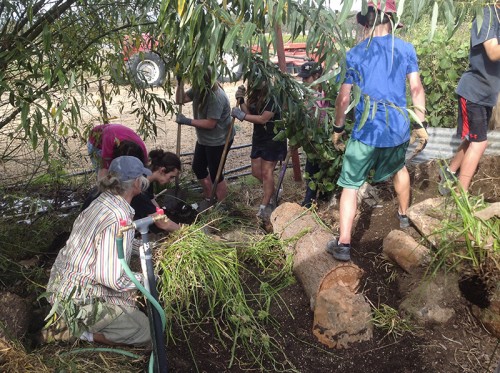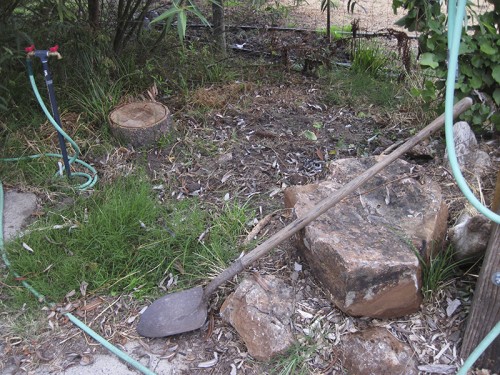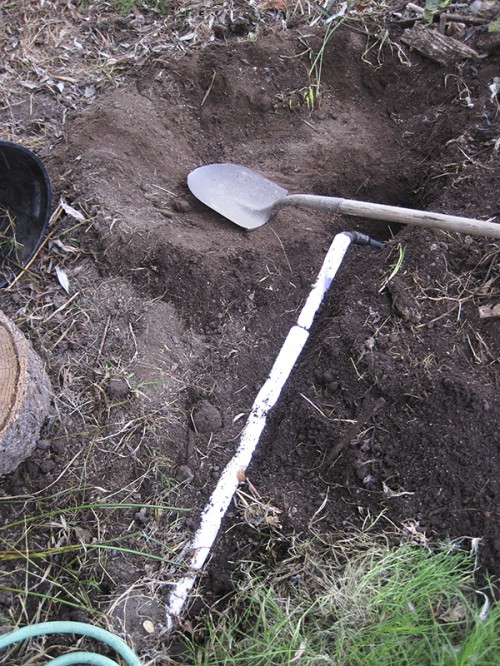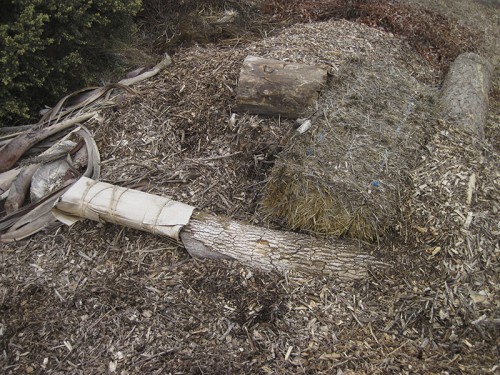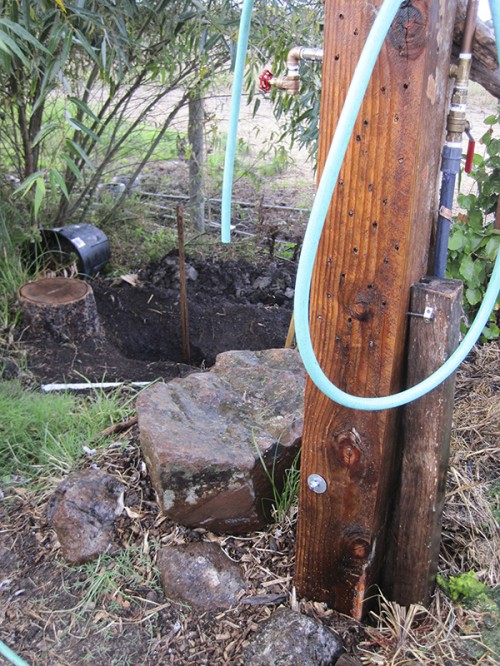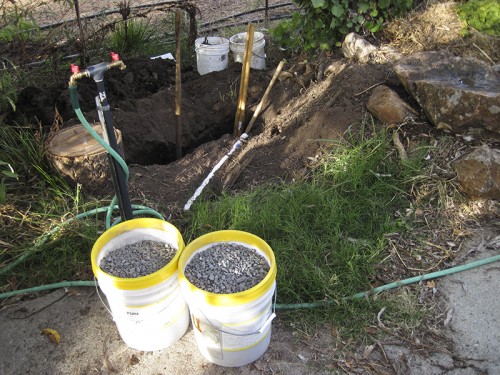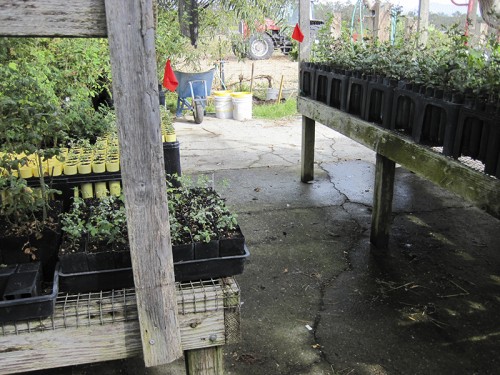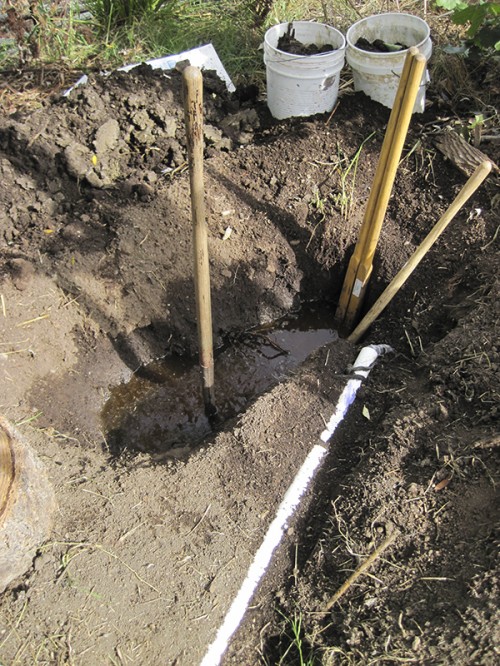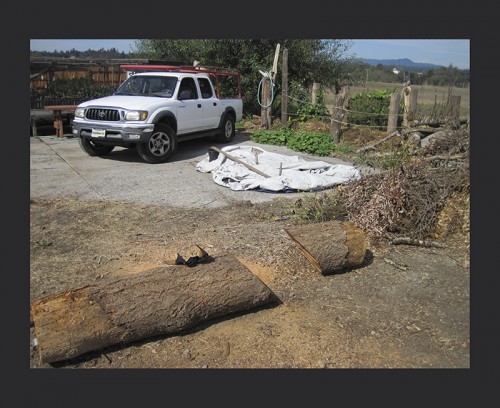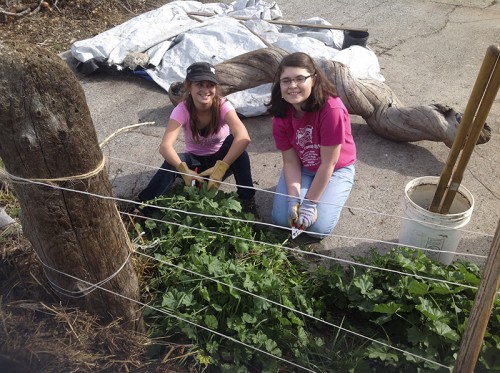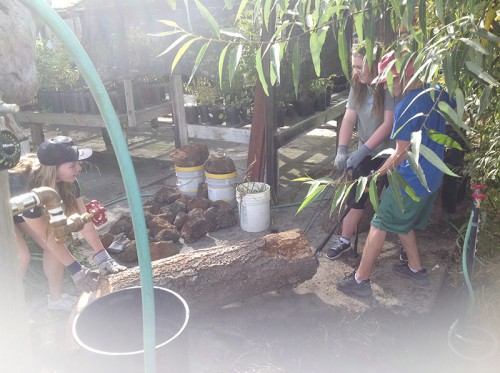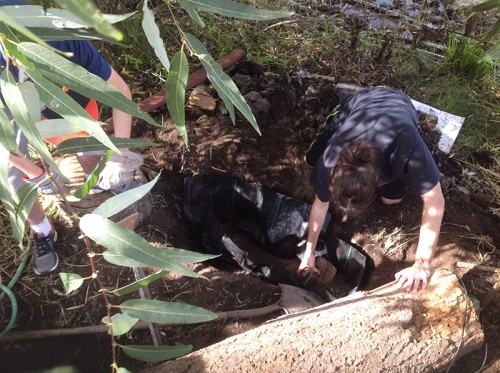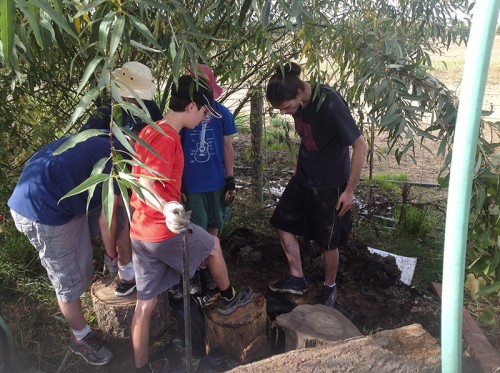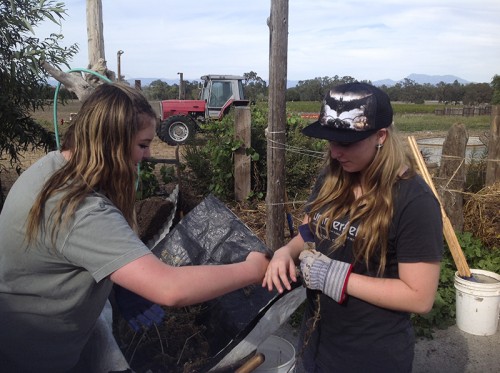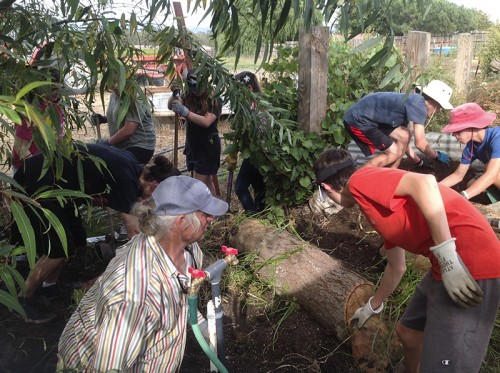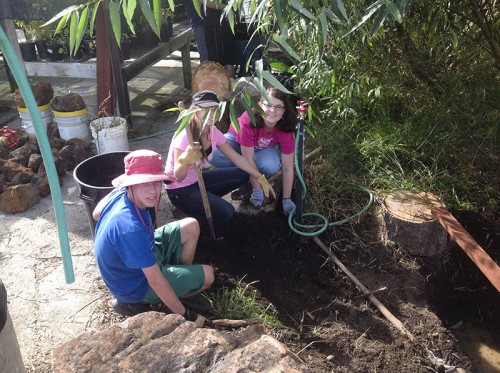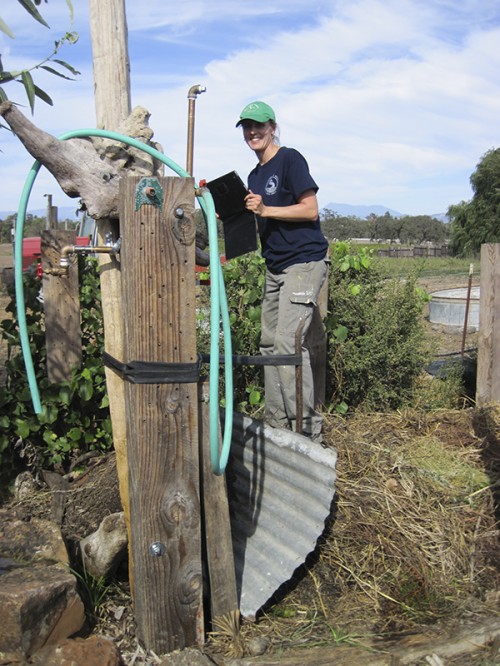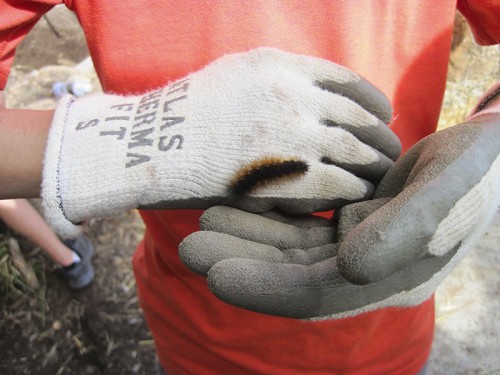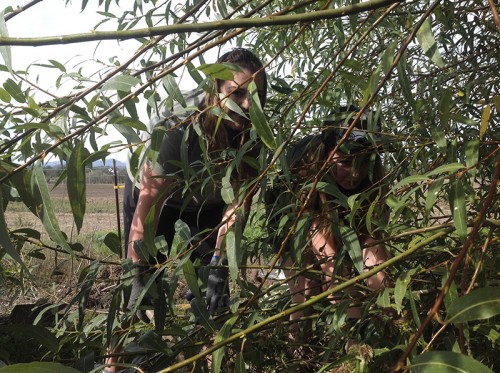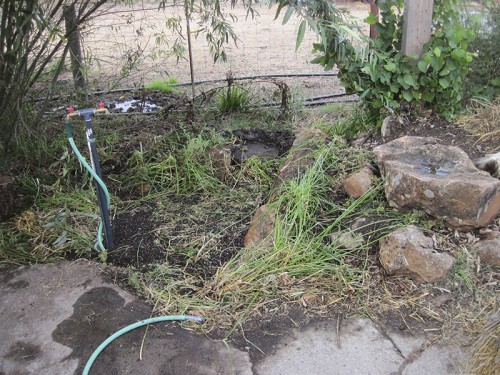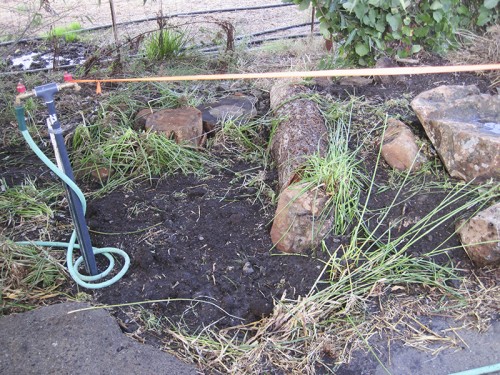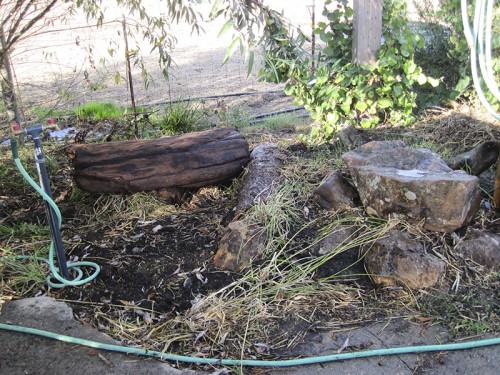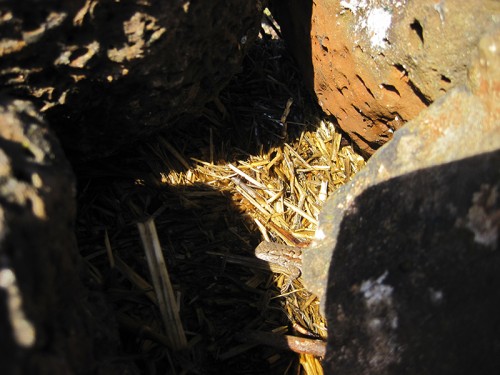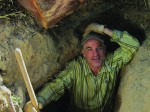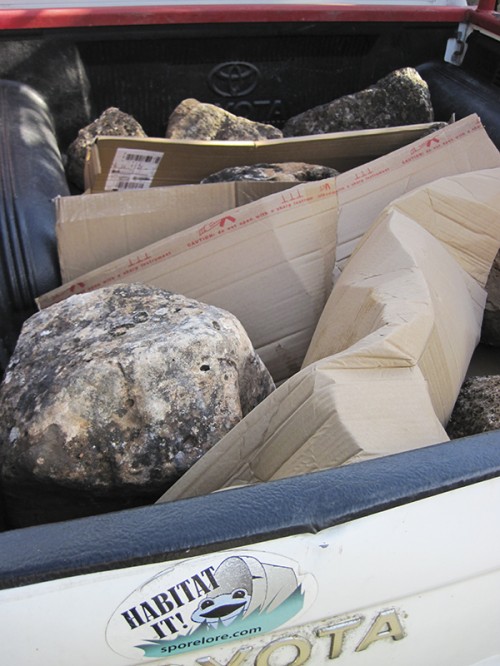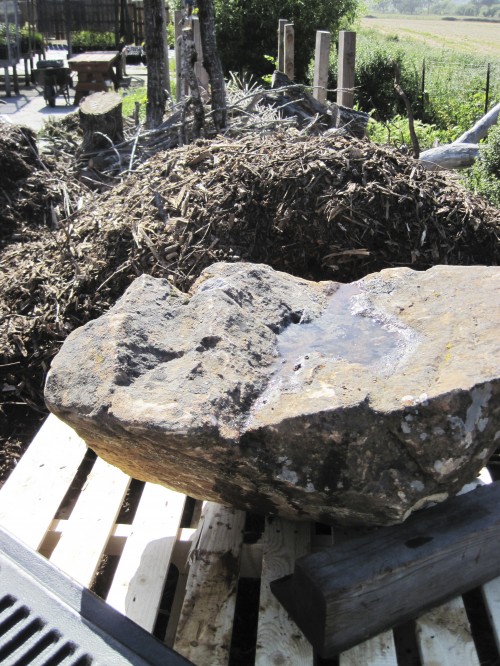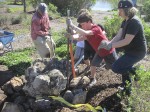
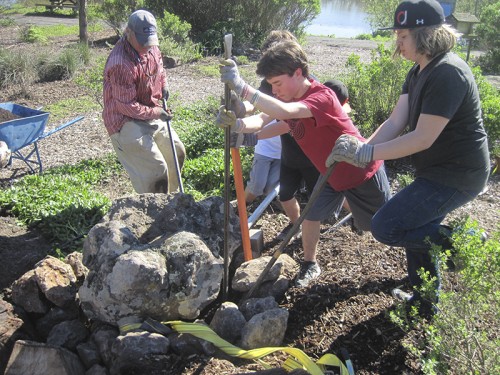 Bee Mountain Pond is a wildlife habitat installation. The plan is to provide a small water bath to the critters of the Native Plant Demonstration Garden at the City of Santa Rosa’s Waste Water Treatment Plant. Address: 4300 Llano Road, Santa Rosa, California 95407.
Bee Mountain Pond is a wildlife habitat installation. The plan is to provide a small water bath to the critters of the Native Plant Demonstration Garden at the City of Santa Rosa’s Waste Water Treatment Plant. Address: 4300 Llano Road, Santa Rosa, California 95407.
Denise Cadman, a Natural Resources Specialist at the Plant, and the overseer/magical wonder of the Native Plant Garden, invited me, Tony McGuigan, of Spore Lore, and my Outdoor Classroom Wildlife Habitat Installation class (name of class is very new) to install a wildlife habitat at the Garden.
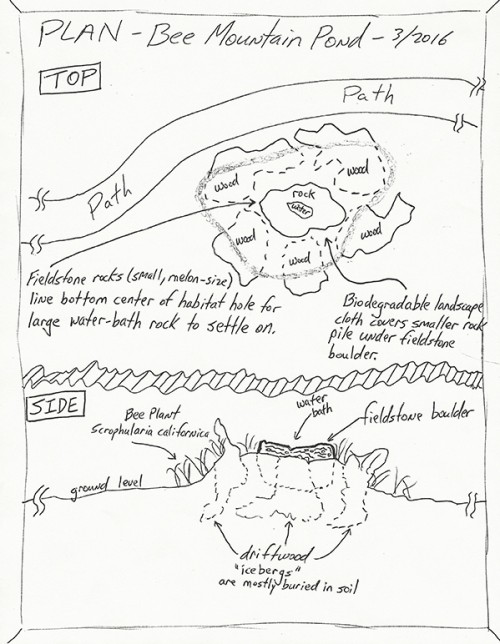 PLAN — Bee Mountain Pond. The mountain is a 1000 pound (1/2 ton) fieldstone landscaping boulder that holds water — a tiny mountain lake for tiny critters. The “Path” is a swath of woodchips for walking through the garden. the pile of subterranean smaller rocks under Bee Mountain will catch any overspill water from the Pond. Critters under the Mountain will have water, shelter, food (tiny critters feeding on the moisture AND on critters feeding on the moisture), and cavities to raise young in — they will have habitat!
PLAN — Bee Mountain Pond. The mountain is a 1000 pound (1/2 ton) fieldstone landscaping boulder that holds water — a tiny mountain lake for tiny critters. The “Path” is a swath of woodchips for walking through the garden. the pile of subterranean smaller rocks under Bee Mountain will catch any overspill water from the Pond. Critters under the Mountain will have water, shelter, food (tiny critters feeding on the moisture AND on critters feeding on the moisture), and cavities to raise young in — they will have habitat!
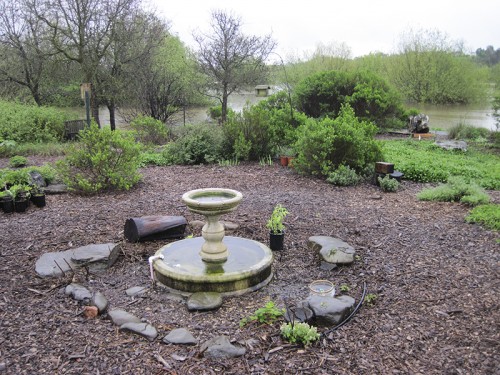 The Before. The Native Plant Garden looks north to the Laguna de Santa Rosa, which is swollen from rain the week before Bee Mountain Pond is installed. In the photo, the birdhouse to the back left marks where the habitat will be installed. Note the woodchip mulch used to keep weeds out and make walking paths.
The Before. The Native Plant Garden looks north to the Laguna de Santa Rosa, which is swollen from rain the week before Bee Mountain Pond is installed. In the photo, the birdhouse to the back left marks where the habitat will be installed. Note the woodchip mulch used to keep weeds out and make walking paths.
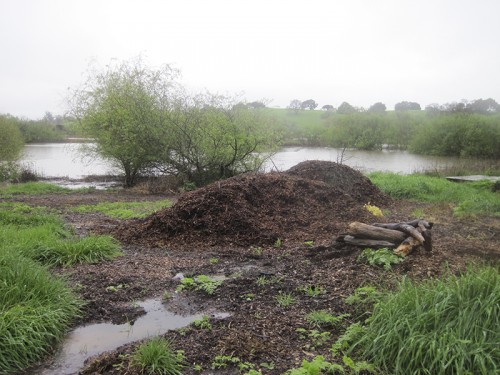 “Driftwood” (river wood washed up on the beach) stored at the Plant’s woodchip pile await installation day, in a week. The rain was so generous to soak the adobe soil and make digging easier.
“Driftwood” (river wood washed up on the beach) stored at the Plant’s woodchip pile await installation day, in a week. The rain was so generous to soak the adobe soil and make digging easier.
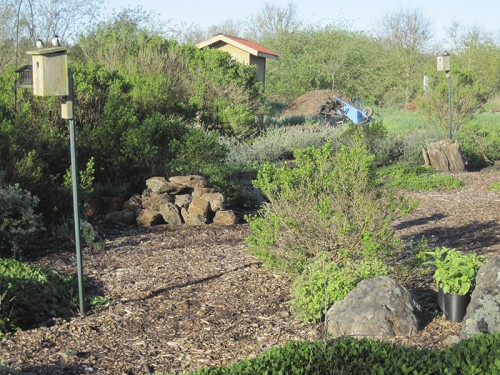 This birdhouse must go! It marks the spot where Bee Mountain Pond will be installed.
This birdhouse must go! It marks the spot where Bee Mountain Pond will be installed.
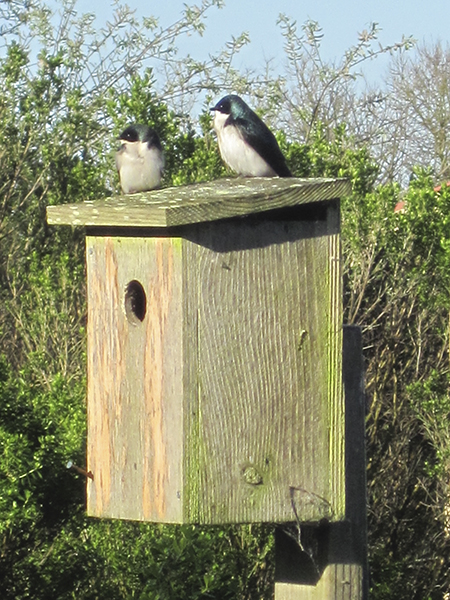 A mating pair of violet-green swallows before the birdhouse is relocated across the Garden.
A mating pair of violet-green swallows before the birdhouse is relocated across the Garden.
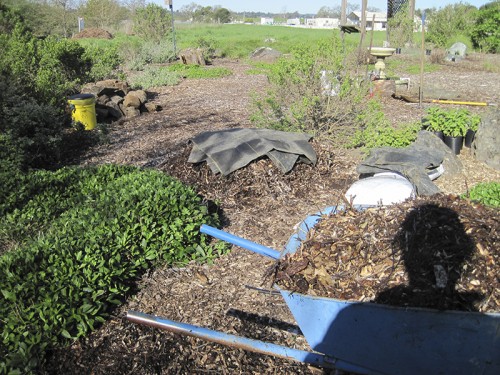 Preparing for Bee Mountain to be moved into position. The half-ton rock will be placed on a mound of woodchips next to is intended resting site. Note the layering of woodchips and tree-hole landscaping cloth; the landscaping cloth will tie together the small hill.
Preparing for Bee Mountain to be moved into position. The half-ton rock will be placed on a mound of woodchips next to is intended resting site. Note the layering of woodchips and tree-hole landscaping cloth; the landscaping cloth will tie together the small hill.
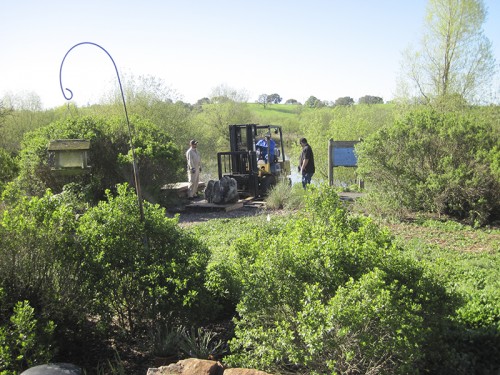 Here comes the rock! Plant employees forklift and move Bee Mountain. Thanks Richard, Tony, and David!
Here comes the rock! Plant employees forklift and move Bee Mountain. Thanks Richard, Tony, and David!
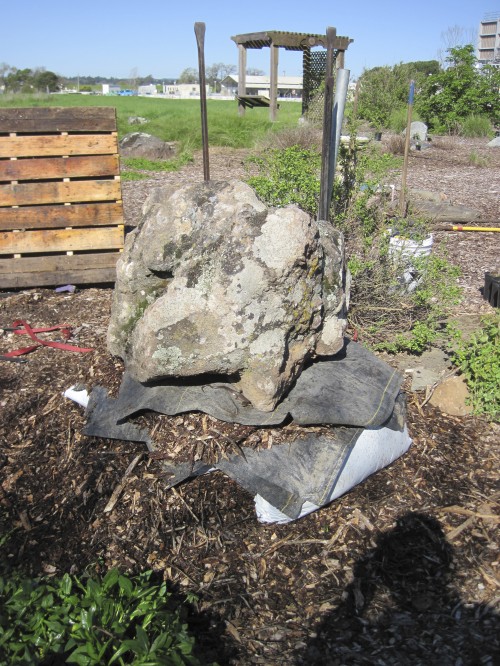 Bee Mountain in place to be repositioned when help arrives — when the students get here. The plan is to “slide” this half ton rock downslope into the habitat. Good luck!
Bee Mountain in place to be repositioned when help arrives — when the students get here. The plan is to “slide” this half ton rock downslope into the habitat. Good luck!
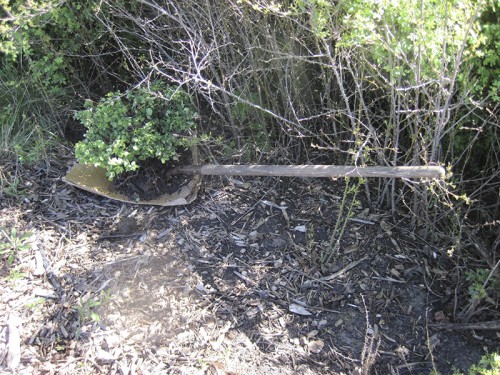 A snowberry, Symphovicarpas alba, is removed to shade while the habitat foundation is created.
A snowberry, Symphovicarpas alba, is removed to shade while the habitat foundation is created.
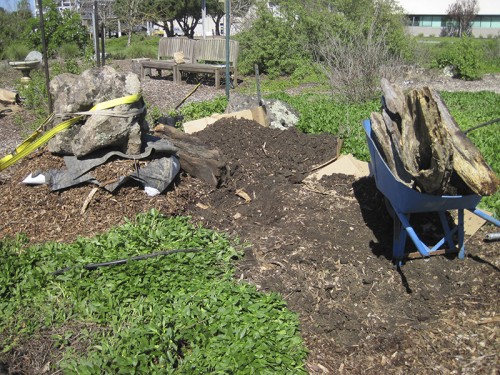 The foundation of the habitat takes place. Center: Topsoil has been scraped from the habitat’s base and shoved to the side (against the cardboard in the rear) for later use during planting the habitat’s newly planted native plants. Right: Riverwood waiting to be buried in the habitat’s berm. The soil berm will be water-loving wood filled and allow for greater diversity of soil level. Note the California aster patches that will ultimately grow together, both in the foreground left and to the side of the habitat, behind the wheelbarrow and cardboard.
The foundation of the habitat takes place. Center: Topsoil has been scraped from the habitat’s base and shoved to the side (against the cardboard in the rear) for later use during planting the habitat’s newly planted native plants. Right: Riverwood waiting to be buried in the habitat’s berm. The soil berm will be water-loving wood filled and allow for greater diversity of soil level. Note the California aster patches that will ultimately grow together, both in the foreground left and to the side of the habitat, behind the wheelbarrow and cardboard.
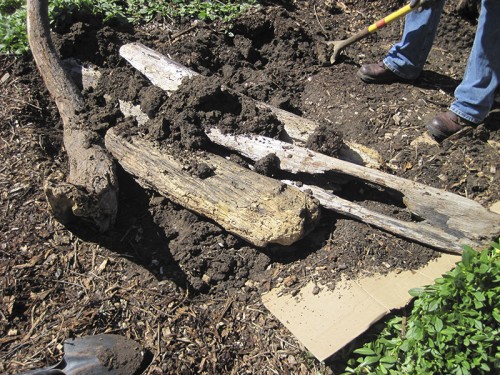 Riverwood layered to form a soil berm above it. Moist nooks and crannies for soil lions, soil tigers, and soil bears, oh my!
Riverwood layered to form a soil berm above it. Moist nooks and crannies for soil lions, soil tigers, and soil bears, oh my!
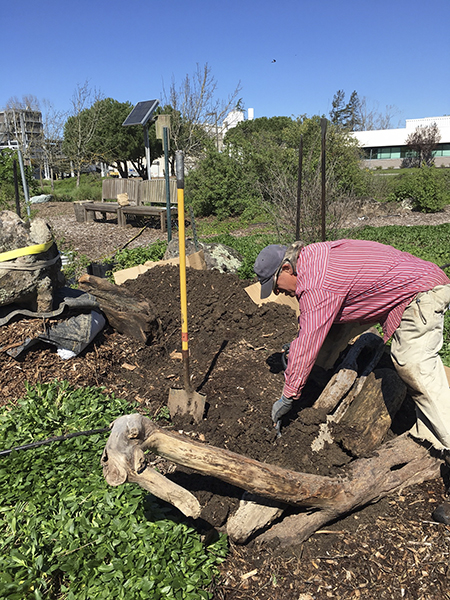 Bee Mountain Pond’s planted soil berm takes shape. Bee Mountain will sit just on the other side of the yellow shovel. Soil from a hole at the base of the Mountain rock will be added to the berm to increase its height. Then, once the berm’s foundation is created with heavy adobe clay sol, the topsoil from Cardboard Dump will be called into action. The “old” topsoil, bagged planting mix, and compost created by the Plant will be mixed as a base for the habitat’s new plantings.
Bee Mountain Pond’s planted soil berm takes shape. Bee Mountain will sit just on the other side of the yellow shovel. Soil from a hole at the base of the Mountain rock will be added to the berm to increase its height. Then, once the berm’s foundation is created with heavy adobe clay sol, the topsoil from Cardboard Dump will be called into action. The “old” topsoil, bagged planting mix, and compost created by the Plant will be mixed as a base for the habitat’s new plantings.
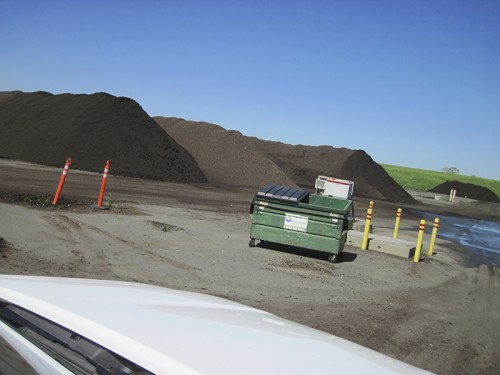 In search of compost, we are told to go the “pile in the back corner” of the Waste Water Treatment Plant’s compost making facility.
In search of compost, we are told to go the “pile in the back corner” of the Waste Water Treatment Plant’s compost making facility.
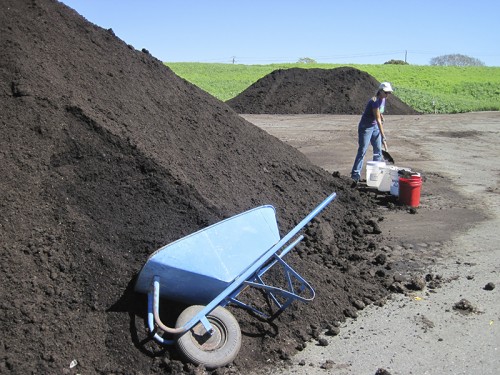 Denise Cadman and I collect state-of-the-art-made compost at the Plant’s compost-making facility.
Denise Cadman and I collect state-of-the-art-made compost at the Plant’s compost-making facility.
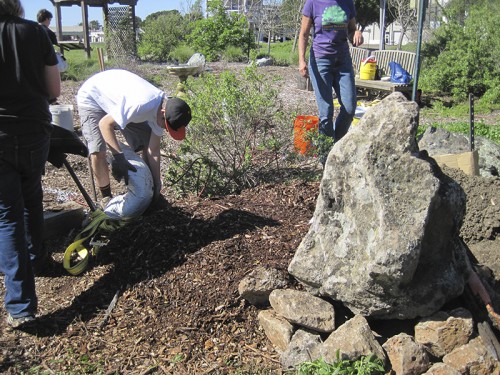 Bee Mountain is almost in place, BUT is pointing skyward, that is, 90 degrees off level. The “peak” will be pulled right and the base will be pulled left, resulting in a level, water-holding position.
Bee Mountain is almost in place, BUT is pointing skyward, that is, 90 degrees off level. The “peak” will be pulled right and the base will be pulled left, resulting in a level, water-holding position.
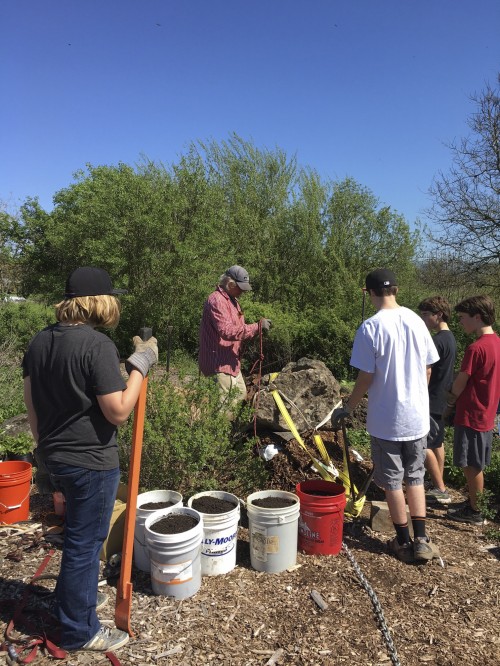 Bee Mountain has been leveled, with the rock’s shallow bowl pointing skyward. Note the buckets of compost awaiting mixing into the planting soil.
Bee Mountain has been leveled, with the rock’s shallow bowl pointing skyward. Note the buckets of compost awaiting mixing into the planting soil.
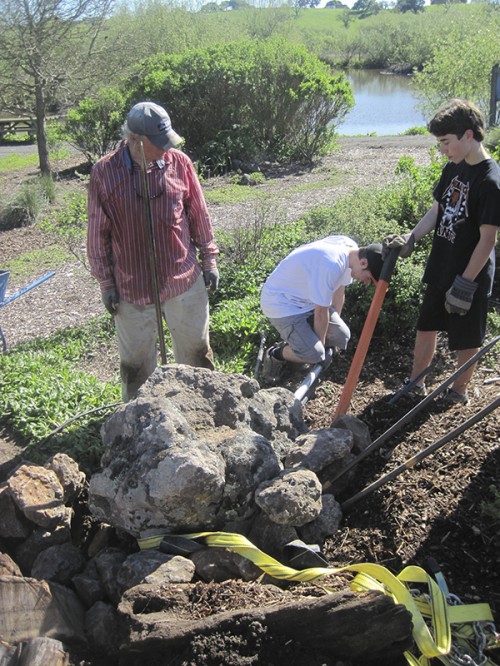 Tweaking Bee Mountain into place. Metal digging bars are used for leverage.
Tweaking Bee Mountain into place. Metal digging bars are used for leverage.
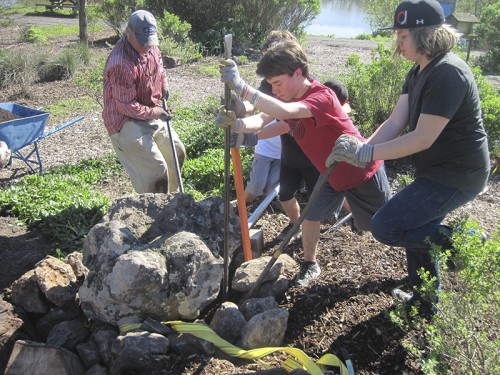 Bee Mountain hovers in place. Stones are used as fulcrums for the digging bars’ leverage.
Bee Mountain hovers in place. Stones are used as fulcrums for the digging bars’ leverage.
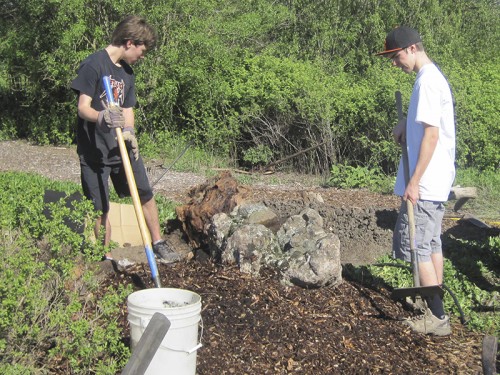 Bee Mountain is leveled to maximize its water-holder capacity. Planting mix is piled up against the fieldstone boulder.
Bee Mountain is leveled to maximize its water-holder capacity. Planting mix is piled up against the fieldstone boulder.
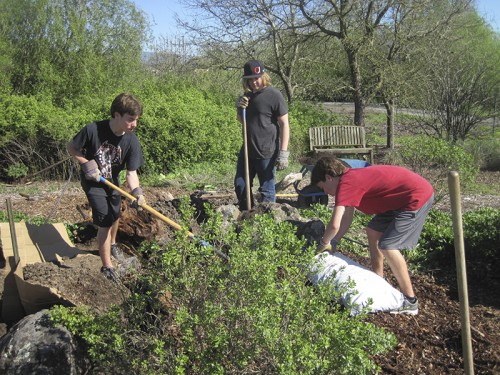 Soil prep for planting out Bee Mountain Pond.
Soil prep for planting out Bee Mountain Pond.
 Native plant seedlings surround Bee Mountain Pond wildlife installation.
Native plant seedlings surround Bee Mountain Pond wildlife installation.
Denise Cadman’s sketch of Bee Mountain Pond.
1) tarweed Madia elegans
2) narrow-leaf milkweed Asclepias fascicularis
3) California aster Symphyotrichum chilense (formerly Aster chilensis)
4) snowberry Symphovicarpas alba
5) Bee Plant, California figwort Scrophularia californica
Sunny Galbraith (Orchard View School) and Denise Cadman add final touches and a little water to the plantings.
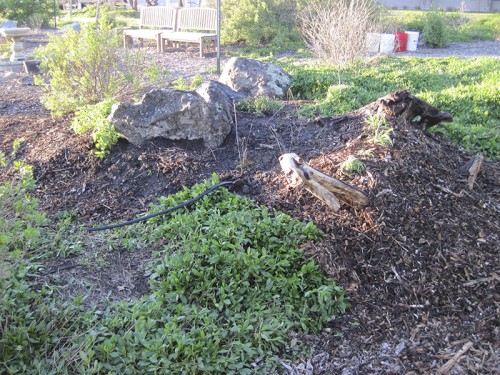 The berm side of Bee Mount Pond. Note how some wood disappears under the berm’s woodchips.
The berm side of Bee Mount Pond. Note how some wood disappears under the berm’s woodchips.
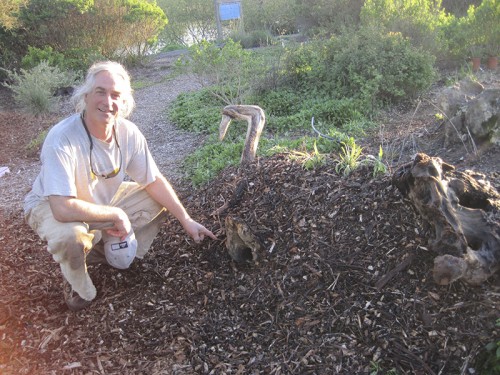 Bee Mountain Pond wildlife habitat installation includes a portal into the berm — all ye small critters enter here!
Bee Mountain Pond wildlife habitat installation includes a portal into the berm — all ye small critters enter here!
And we are done. Bee Mountain Pond has been installed. Thank you to the City of Santa Rosa, Waste Water Treatment Plant administrators and Denise Cadman for inviting me, Tony McGuigan, of Spore Lore, and Sunny Galbraith, teacher at Orchard View School, of Sebastopol, and her students, to create this wildlife habitat installation at the Plant’s Native Plant Garden.
Enjoy your wildlife habitat installations. Habitat it!
Tony

